Scottish Greenhouse Gas Emissions 2014
This publication provides estimates of greenhouse gas emissions in Scotland for the years 1990 to 2014.
This document is part of a collection
Section D. Revisions to the Inventory and Methodology
This section examines key revisions in estimated source emissions between the latest inventory (1990-2014) and the previous inventory (1990-2013) published in June 2015. It also provides a summary of the cumulative impact of revisions since the 1990-2008 inventory. In October 2015, the Scottish Government published a paper Scottish Greenhouse Gas Emissions 2013. Key Revisions Since 2008, which provides a breakdown of the key revisions to the data within the Scottish Greenhouse Gas Emissions Official Statistics publication over successive years from the 1990-2008 inventory to the 1990-2013 inventory. This section of the publication is intended to build on this revisions paper.
Compilation of the Greenhouse Gas Inventory
The greenhouse gas inventory covers a wide variety of anthropogenic sources of greenhouse gas emissions. There is therefore a wide variety of emissions sources which require different approaches to their estimation. There are a large number of data sources used in its compilation, obtained from Government statistics, regulatory agencies, trade associations, individual companies, surveys and censuses. The methods used to compile the greenhouse gas inventory are consistent with international guidance on national inventory reporting from the Intergovernmental Panel on Climate Change.
Most emission estimates are compiled by combining activity data (such as fuel use) with a suitable emission factor (such as amount of CO 2 emitted per unit of fuel used). Estimates of emissions from the industrial sector are often compiled based on plant-specific emissions data. Emissions from some sectors are based on more complicated models - such as the model used to estimate emissions from landfill, and the model used to estimate the carbon dynamics in soils when trees are planted. Much of the data on net emissions from agriculture and related land use, land use change and forestry emissions are based on modelled data for Scotland, which are consistent with, but not constrained to, the UK totals and thus are known as "bottom up" estimates.
Many of the remaining emissions sources within the inventory have been collated on a "top down" approach where estimates of emissions have been apportioned to Scotland using proportions of energy use in the Department of Energy and Climate Change ( DECC) Publication "Digest of UK Energy Statistics ( DUKES)". This approach is prompted by data availability on emissions being more limited at the sub- UK level.
Impact of Revisions
Revisions between the 1990-2013 and 1990-2014 inventories
Charts D1 to D3 and Table D1 illustrate the impacts of revisions between the 1990-2013 and 1990-2014 inventories, both by sector and by greenhouse gas. This is followed by a discussion of the reasons for the key revisions.
Chart D1. Scottish Greenhouse Gas Emissions. Comparison of 1990-2013 and 1990-2014 Inventories. Values in MtCO 2e
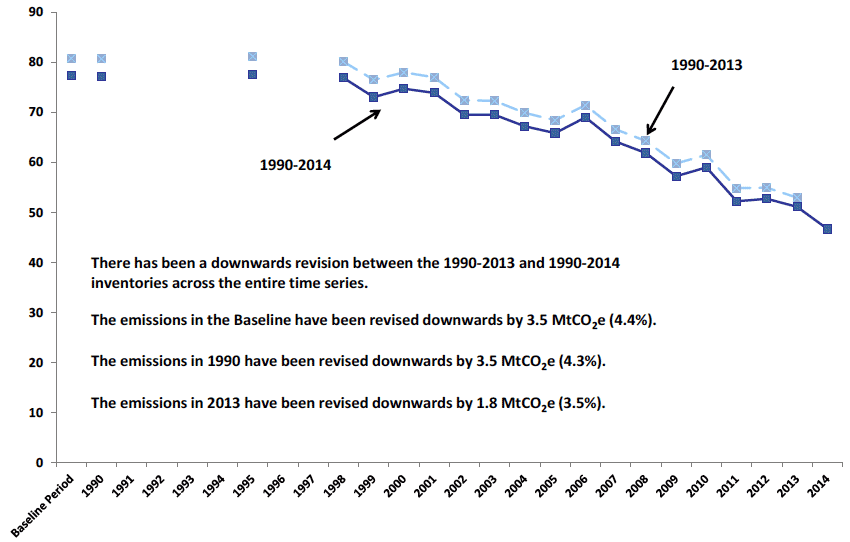
Chart D2 shows that the nearly all the downward revisions to the Baseline period occurred in the Agriculture and Related Land Use and Forestry sectors (revised downwards by 1.9 MtCO 2e and 1.7 MtCO 2e respectively). Other sectors saw very little change between the 1990-2013 and 1990-2014 inventories, with a slight (0.1 MtCO 2e) increase in emissions from transport (including international aviation and shipping).
Chart D2. Revisions to emissions in the Baseline Period, from the 1990-2013 inventory to the 1990-2014 inventory, by source sector. Values in MtCO 2e, and percentage changes
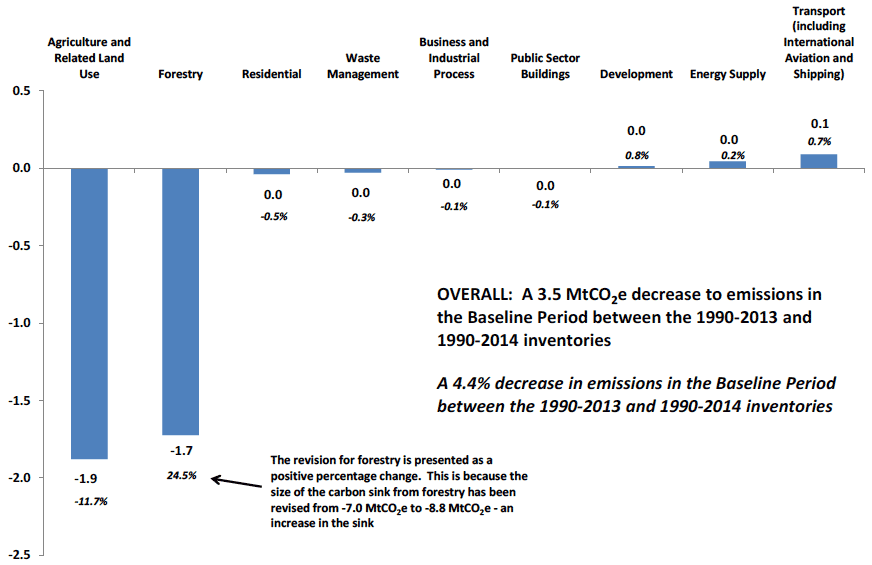
Chart D3 shows that the greatest downwards revision in 2013 occurred in the Agriculture and Related Land Use sector (1.5 MtCO 2e; contributing to 83.8 per cent of net downwards revisions). The second largest downwards revision occurred in forestry (0.3 MtCO 2e). There was a much smaller downward revision in the Waste Management sector (0.1 MtCO 2e) and a small upward revision in the Business and Industrial process sector (0.1 MtCO 2e).
Chart D3. Revisions to emissions in 2013, from the 1990-2013 inventory to the 1990-2014 inventory, by source sector. Values in MtCO 2e, and percentage changes
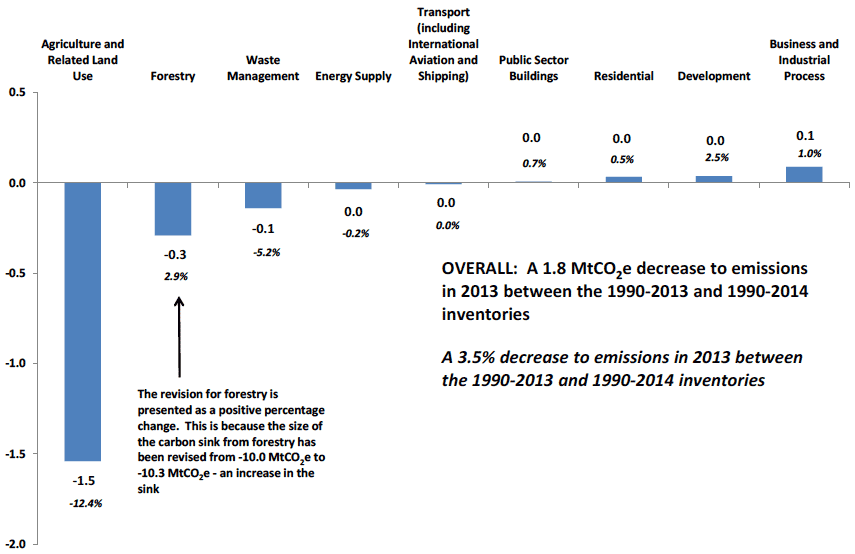
Table D1. Changes in emissions by source sector. Comparison of 1990-2013 and 1990-2014 inventories. Values in MtCO 2e
| Baseline Period | 1990 | 2013 | 2014 | % change between Baseline Period and 2013 |
% change between 1990 and 2013 |
% change between Baseline Period and 2014 |
% change between 1990 and 2014 |
|
|---|---|---|---|---|---|---|---|---|
| Total | ||||||||
| 1990-2013 | 80.8 | 80.7 | 53.0 | -34.4% | -34.3% | |||
| 1990-2014 | 77.3 | 77.2 | 51.1 | 46.7 | -33.8% | -33.7% | -39.5% | -39.5% |
| Difference between 1990-2013 and 1990-2014 | -3.5 | -3.5 | -1.8 | |||||
| Energy Supply | ||||||||
| 1990-2013 | 22.7 | 22.7 | 16.0 | -29.5% | -29.5% | |||
| 1990-2014 | 22.8 | 22.8 | 16.0 | 13.8 | -29.8% | -29.8% | -39.2% | -39.2% |
| Difference between 1990-2013 and 1990-2014 | 0.0 | 0.0 | 0.0 | |||||
| Transport (including International Aviation and Shipping) | ||||||||
| 1990-2013 | 13.2 | 13.2 | 12.9 | -2.1% | -2.1% | |||
| 1990-2014 | 13.3 | 13.3 | 12.9 | 12.9 | -2.8% | -2.8% | -2.8% | -2.8% |
| Difference between 1990-2013 and 1990-2014 | 0.1 | 0.1 | 0.0 | |||||
| Agriculture and Related Land Use | ||||||||
| 1990-2013 | 16.1 | 16.1 | 12.4 | -23.1% | -23.1% | |||
| 1990-2014 | 14.2 | 14.2 | 10.9 | 10.7 | -23.7% | -23.7% | -25.0% | -25.0% |
| Difference between 1990-2013 and 1990-2014 | -1.9 | -1.9 | -1.5 | |||||
| Business and Industrial Process | ||||||||
| 1990-2013 | 14.4 | 14.3 | 9.1 | -36.6% | -36.3% | |||
| 1990-2014 | 14.3 | 14.3 | 9.2 | 8.7 | -35.9% | -35.8% | -39.7% | -39.6% |
| Difference between 1990-2013 and 1990-2014 | 0.0 | 0.0 | 0.1 | |||||
| Residential | ||||||||
| 1990-2013 | 8.0 | 8.0 | 7.0 | -13.0% | -12.4% | |||
| 1990-2014 | 8.0 | 7.9 | 7.0 | 5.9 | -12.1% | -11.5% | -26.5% | -26.0% |
| Difference between 1990-2013 and 1990-2014 | 0.0 | 0.0 | 0.0 | |||||
| Waste Management | ||||||||
| 1990-2013 | 9.9 | 9.9 | 2.7 | -72.6% | -72.6% | |||
| 1990-2014 | 9.8 | 9.8 | 2.6 | 2.2 | -73.9% | -73.9% | -77.3% | -77.3% |
| Difference between 1990-2013 and 1990-2014 | 0.0 | 0.0 | -0.1 | |||||
| Development | ||||||||
| 1990-2013 | 1.8 | 1.8 | 1.6 | -14.7% | -14.7% | |||
| 1990-2014 | 1.8 | 1.8 | 1.6 | 1.6 | -13.4% | -13.4% | -13.8% | -13.8% |
| Difference between 1990-2013 and 1990-2014 | 0.0 | 0.0 | 0.0 | |||||
| Public Sector Buildings | ||||||||
| 1990-2013 | 1.7 | 1.7 | 1.2 | -26.2% | -26.2% | |||
| 1990-2014 | 1.7 | 1.7 | 1.3 | 1.1 | -25.7% | -25.7% | -36.2% | -36.2% |
| Difference between 1990-2013 and 1990-2014 | 0.0 | 0.0 | 0.0 | |||||
| Forestry [17] | ||||||||
| 1990-2013 | -7.0 | -7.0 | -10.0 | 42.0% | 42.0% | |||
| 1990-2014 | -8.8 | -8.8 | -10.3 | -10.2 | 17.3% | 17.3% | 16.1% | 16.1% |
| Difference between 1990-2013 and 1990-2014 | -1.7 | -1.7 | -0.3 | |||||
Details of Main Revisions and Interpretation of Revisions to the Inventory
Revisions to emission inventory estimates reflect the continuous development of scientific understanding of emissive processes, and the improvement to underlying data and methods to generate accurate emission estimates; few revisions to the Greenhouse Gas Inventories arise as a result of 'errors' in the popular sense of the word. The compilation of the inventory is governed by a rigorous quality assurance process and is subject to a great deal of third party scrutiny, such as annual reviews by the UNFCCC of the UK inventory.
However, in 2014 there have been two revisions which have occurred as a result of errors in datasets supplied by a third party which feed into the UK and in turn the Scottish inventory. These have been corrected within the 1990-2014 inventory.
The latest published Scotland greenhouse gas inventory (currently 1990-2014) represents the best available data at the time and these supersede any previous data, which should be disregarded.
A complete list of the revisions between the previous and latest inventories can be found in the National Atmospheric Emissions Inventory report Greenhouse Gas Inventories for England, Scotland, Wales and Northern Ireland: 1990 - 2014 [18] . Details of the most notable revisions are listed below:
1. Forestry.
Correction to model used to estimate net emissions from forestry and harvested wood products
The output from the model used to estimate the net emissions from forestry was corrected by inventory compilers as part of the Land Use, Land Use Change and Forestry ( LULUCF) inventory. This correction occurred because the estimates of carbon sequestered from forestry had been previously assigned to the wrong years in the UK-wide model. This affects the subcategories of forest land remaining forest land and harvested wood products. The impact of this correction has resulted in a downwards revision across the time series (of 1.7 MtCO 2e in 1990 and of 0.3 MtCO 2e in 2013), compared to the 1990-2013 inventory published in June 2015.
A series of steps are being put in place to reduce the likelihood of such errors occurring in future inventories. The Scottish Government is represented at the UK's National Inventory Steering Committee ( NISC), where improvements to the Scottish and UK inventories are discussed. As part of the NISC, a major programme of work has been recently launched to review and improve the quality assurance and quality control processes within the models used in the greenhouse gas inventory. The UK Department for Energy and Climate Change ( DECC) has published tools and guidance to help people with quality assurance of analytical models [19] .
2. Agriculture and Related Land Use
Correction to emissions of drainage of grasslands on organic soils
The emission factor used for grassland drainage was corrected by inventory compilers as part of the Land Use, Land Use Change and Forestry ( LULUCF) inventory. In the 1990-2013 inventory, the IPCC (2006) [20] emission factor for cultivated organic soils was used for grassland on drained organic soils. This has been replaced with the correct emission factor for drainage of grasslands on organic soils for the 1990-2014 inventory. This has resulted in an decrease in 0.96 MtCO 2e across each year in the time series and has increased the size of carbon sink from grasslands.
3. Agriculture and Related Land Use
Impacts of research to derive more representative, UK-specific emission factors to Nitrous Oxide emissions in the Agriculture and Related Land Use sector
There is a large programme of work underway to better quantify and reduce uncertainty in UK and Scottish agriculture emissions. This is known as the Agricultural Greenhouse Gas Inventory Research Platform and consists of a consortia of a wide range of scientific expertise [21] including many leading academic experts from Scottish universities and institutions. The research programme over recent years has gathered evidence on agricultural processes and emissions, specific to UK conditions (soils, climate, farm management practices etc.) in order to improve the accuracy of emission factors for greenhouse gas emissions. The first improvements from the Agriculture Platform have been introduced for the 1990-2014 inventory and are as a result of new UK-specific emissions factors. These result in revisions to nitrous oxide ( N 2O) emissions, with further improvements to methane ( CH 4) emissions likely to be introduced for the 1990-2015 inventory.
The main revisions have been to the Agricultural Soils subcategory. These include:
- the direct estimation of UK-specific emissions factors for N 2O from agricultural soils using IPCC (2006) [22] guidelines. Previously, the emission estimates were based on a standard non- UK specific value.
- new UK-specific emissions factors for indirect emissions from N 2O leaching and run-off which have replaced IPCC default values.
- the harmonisation of the models used to estimate indirect emissions of nitrous oxide from atmospheric deposition with those estimates of ammonia used for the UK's Air Pollution inventory [23] .
In addition, new UK specific emissions factors have been calculated for direct N 2O sources from urine and dung deposited by grazing animals
The overall impact of these improvements has been to lower the emissions estimates in the Agriculture and Related Land Use sector across the time series, by around 1.16 MtCO 2e in 1990 and by around 0.82 MtCO 2e in 2013.
Note that prior to this UK research, the emissions of nitrous oxide from soils were by far the most uncertain single emission estimate in the UK and Scottish inventories. This was due to the considerable uncertainty in the emission factors for the sources listed above, where international defaults were previously applied to represent UK conditions and activities. This improvement was one of the key improvements which has lowered the overall level of uncertainty in the Scottish greenhouse gas inventory.
Interpretation of uncertainties in the inventory
All estimates, by definition, are subject to a degree of statistical 'error' but in this context it relates to the uncertainty inherent in any process or calculation that uses sampling, estimation or modelling.
Estimates of greenhouse gases are compiled by a consortium of contractors. The source emissions are based upon a range of data sources, ranging from model based estimates to point source emission data. As a result, the estimates are subject to a degree of uncertainty. Full analyses of these uncertainties are provided on the National Atmospheric Emissions Inventory website.
The Scottish Government has commissioned research to overhaul and update the uncertainties model used for the Scottish greenhouse gas inventory. A detailed study was carried out in parallel with the compilation with the 1990-2013 Scottish greenhouse gas inventory to review and improve the uncertainty calculations. A link to this project and to the full report can be found in the Scottish Greenhouse Gas Inventory Uncertainties Project.
These uncertainty calculations have been updated for the 1990-2014 inventory. The outcome is a model that delivers more accurate and lower estimates of uncertainty for Scottish greenhouse gas emissions (9% uncertainty for 2014 emissions), and a narrower range of "Base year to latest year" Greenhouse Gas trends (-41%, within a -33% to -49% range). Note that these calculations exclude emissions from international aviation and shipping.
Future revisions to the inventory
Every year, greenhouse gas inventories are updated to reflect improvements in the underpinning science, data and modelling which often result in revisions to the entire time series. These revisions also reflect changes to the Intergovernmental Panel on Climate Change ( IPCC) guidelines. The Scottish Government is represented at the UK's National Inventory Steering Committee, where improvements to the Scottish and UK inventories are discussed. Some of the changes for the 1990-2015 inventory and for subsequent inventories are already known. However, the exact magnitude and direction of future revisions are not currently clear but on balance we might expect emissions to increase over subsequent inventories.
There are a number of projects underway which might result in considerable revisions for future inventories in a number of sectors. For instance:
- There is a large project underway to improve estimates of domestic and international shipping emissions;
- Further results from the Agriculture greenhouse gas platform will become available. For instance, improved estimates of methane will be introduced as well as potentially more specific emissions factors for devolved administrations;
- There is a project underway to better understand the behaviour of drained organic soils and the impact of this on how forests release or sequester carbon. This may increase net emissions in this sector. However, this may be counteracted by new data from the National Forest Inventory;
- There is likely to be a review of the carbon factors of some of the fuels not included in the EU Emissions Trading System ( EU ETS), as these have not been reviewed for a number of years;
- An improved methodology is being developed to better represent emissions from land use changes, although this is not expected for the 1990-2015 inventory.
Note that there are likely to be further revisions in the 1990-2015 inventory which have not been noted within this publication.
Cumulative revisions since 1990-2008
Revisions since the 1990-2008 inventory give a flavour of the scale of total revisions since the establishment of fixed annual Climate Change targets. Chart D4 shows that the Baseline has been revised upwards in every successive inventory from the 1990-2008 to 1990-2013, with a downwards revision to the Baseline between 1990-2013 and 1990-2014. Overall there was been a cumulative increase in emissions. Between the 1990-2008 inventory and the latest inventory, the average yearly increase in emissions in the Baseline Period has been 1.2 MtCO 2e.
Chart D4. Revisions to emissions in the Baseline Period, from the 1990-2008 Inventory, to the Latest Inventory. Impact of Successive Revisions. Values in MtCO 2e
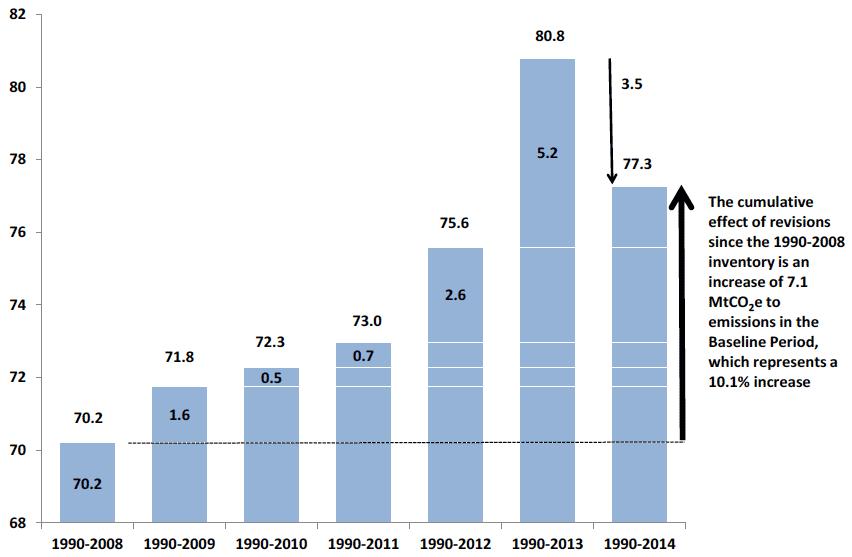
Charts D5 shows the cumulative effect of revisions to the greenhouse gas inventory from 1990-2008 to the latest (1990-2014) inventory across the time series. Chart D6 shows the cumulative effect of revisions to the Baseline from the 1990-2008 inventory, by source sector.
Chart D5. Scottish Greenhouse Gas Emissions, Comparison of 1990-2008 and 1990-2014 Inventories. Values in MtCO 2e
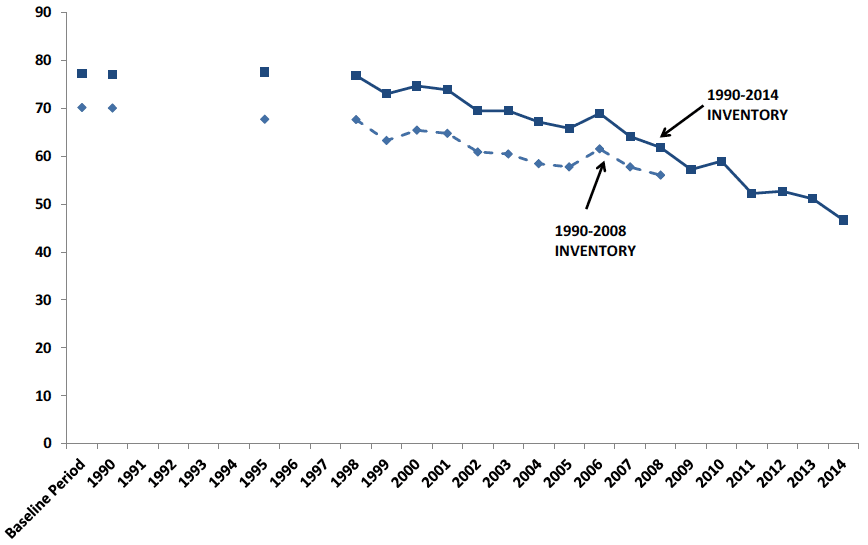
There has been a cumulative upwards revision between 1990-2008 and 1990-2014 across the entire time series.
The emissions in the Baseline have been revised upwards by 7.1 MtCO 2e (10.1%)
The emissions in 1990 have been revised upwards by 7.1 MtCO 2e (10.1%)
The emissions in 2008 have been revised upwards by 5.8 MtCO 2e (10.3%)
Chart D6. Revisions to the Baseline, from the 1990-2008 Inventory to the Latest Inventory (1990-2014), by source sector. Impact of Successive Revisions. Values in MtCO 2e, and percentage changes [24]
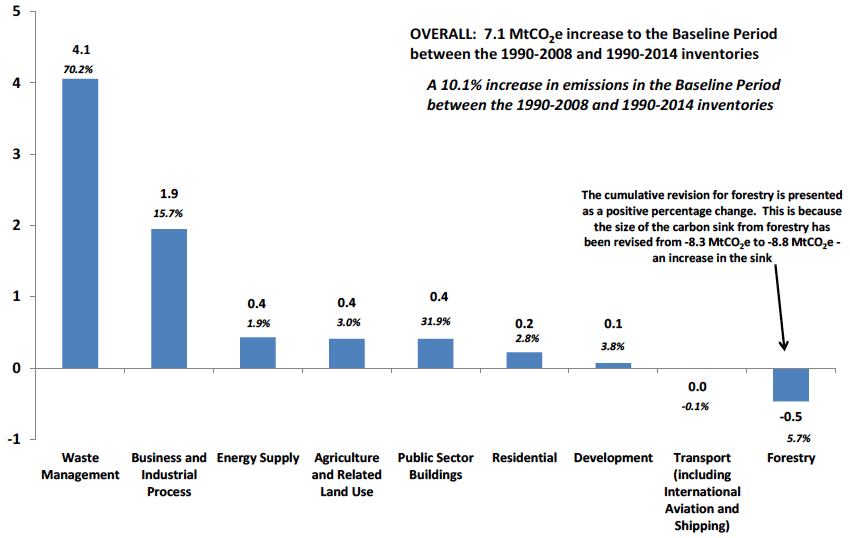
A discussion of the main causes of the upwards revisions between 1990-2008 and the 1990-2013 inventories can be found within the methodology paper: Scottish Greenhouse Gas Emissions 2013. Key Revisions Since 2008.
Contact
There is a problem
Thanks for your feedback